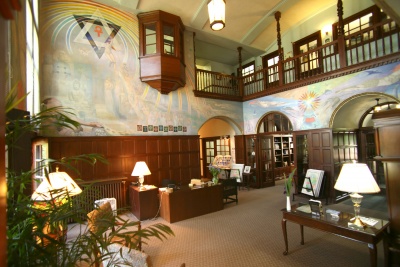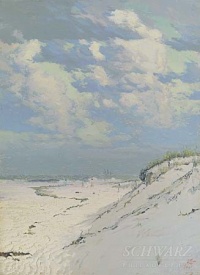Richard Blossom Farley: Difference between revisions
| Line 71: | Line 71: | ||
</blockquote> | </blockquote> | ||
== Later years == | == Later years at Sarobia == | ||
By 1931, Blossom Farley was spending time at Sarobia, near Eddington, Pennsylvania, the estate of Robert Restalrig Logan and his wife, Sara Northrup Wetherill. He attended a birthday party for Theosophist poet [[James H. Cousins|Dr. James Henry Cousins]].<ref>"Dr. Cousins Feted at Birthday Party" ''Trenton Evening Times'' (August 2, 1931), 32.</ref> When the artist contracted tuberculosis, the Logans invited him to live at Sarobia, which had become an artists' colony with a bohemian reputation. Troupes of actors spent the summer at Sarobia performing in a barn converted into a playhouse. The Logans were vegetarians, raising their food in gardens and greenhouses. They were very active in the American Anti-Vivisection Society and in the [[Theosophical Order of Service]], and Sara maintained her connection with the Art Alliance in Philadelphia, with which Blossom Farley was also associated. | |||
Sara Logan died on December 2, 1935, and bequeathed to Farley $200 of her personal estate.<ref>"Mrs. Logan's Will Filed for Probate" ''Trenton Evening Times'' (December 12, 1938), 14.</ref> The artist continued to live at Sarobia for the rest of his life, enjoying the rural existence and the company of Robert Logan in frequent chess games. Construction projects took up much of his time. He built at four-story tower where he stayed in winter, and an underground cave home for hot summers. He lined the cave in river stones and concrete. | |||
Blossom Farley died on ........... Two years later, his friend Robert Logan also passed away, leaving the Sarobia estate to the state, where it became the Neshaminy State Park. | |||
== Notes == | == Notes == | ||
Revision as of 21:51, 19 August 2019
UNDER CONSTRUCTION
UNDER CONSTRUCTION
Richard Blossom Farley was a Philadelphia painter who created the murals in the lobby of the L. W. Rogers Building, headquarters of the Theosophical Society in America with the sponsorship of Georgine Wetherill Smith. He preferred to be called Blossom.
Early life and education
Farley was born at Poultney, Vermont on October 24, 1875, to teacher Dickerson Harvey Farley and Freberne Lucia Blossom. The young family has relocated to Trenton, New Jersey by 1880, and two more sons were born: Marcus and LeRoy. The father became an instructor and then professor in the State Normal School. All three boys lived with their parents throughout their schooling. The eldest attended various art schools; Marcus trained as a civil engineer; and LeRoy became a dentist.
Richard Blossom Farley was trained at the Academy of Fine Arts in Philadelphia when Cecilia Beaux and William H. Chase were instructors in portraiture. After the academy awarded him an $800 European Traveling Scholarship, he went to Paris and studied under James McNeill Whistler in 1898-1899.[1] He also spent time in England, Belgium, and Brittany.
By 1914, Blossom Farley was a well-established artist, with many exhibitions and prizes to his name. He married Abigail Rosenthal, and they set up a household.[2] A son was born on December 3, 1918 and named after his father. A daughter, Abigail Freberne Farley was born on August 3, 1920. They lived in rural Newtown Township, Bucks County, north of Philadelphia and just west of Trenton, and may have done some farming for a time.[3] By 1925, however, the artist was again living in Philadelphia and maintaining a studio there.[4] After Mrs. Abigail Farley died on January 2, 1926, the girl was sent to live with her aunt Miriam who was married to a wealthy Pittsburgh steel manufacturer, Samuel Heppenstall.[5] The outcome of the son, Richard Blossom Farley Jr., is unknown.
Artistic career
Blossom Farley worked steadily as a prolific and successful studio artists, painting landscapes for sale at exhibitions and portraits on commission. During World War I, he worked for the U. S. Shipping Board as a "camoufleur," painting ships in camouflage designs to protect them from attack.[6]
The artist was featured in numerous exhibitions such as these:
- 1906 – Philadelphia Academy of Fine Arts
- 1911 - Peabody Institute, Baltimore
- 1912 – Pennsylvania Academy of Fine Arts
- 1913 – Art Club of Philadelphia
- 1913 – MacDowell Club Gallery, New York City
- 1915 – Silver Medal, Panama Pacific Exhibit in San Francisco
- 1916 – Arlington Galleries, New York City
- 1921 - Carnegie Library, Fort Worth
- 1922 – National Academy of Design, New York City
- 1925 – Trenton Fair Art Club
He artist received significant prizes and awards:
- 1897 – Charles Toppan Prize, as student at the Pennsylvania Academy of Fine Arts
- 1898 – European Traveling Scholarship Prize, Pennsylvania Academy of Fine Arts ($800)
- 1910 – Fellowship Prize, Pennsylvania Academy of Fine Arts ($100)
- 1912 – Fellowship, Pennsylvania Academy of Fine Arts ($100)
- 1913 – Gold Medal, Philadelphia Arts Club Exhibition
- 1914 – Fourth W. A. Clark Prize ($500) and Honorable Mention, at Corcoran Art Gallery, Washington, D.C., in an exhibition of contemporary American oil paintings
- 1915 – Silver Medal Panama-Pacific International Exposition, San Francisco
His works are represented in the permanent collections of the Pennsylvania Academy of Fine Arts with "Morning Mists;" the Reading, Pennsylvania Museum with "The Passing Cloud;" and at the Corcoran Art Gallery, Washington, D. C. with "Fog" and "Blue and Gold." Well-known subjects of his portraits include Trenton Mayor Frederick William Donnelly, Miss Sarah Y. Ely, and Professor Austin Apgar. A portrait of Christine Wetherill Stevenson can be seen at the Philadelphia Art Alliance.
Murals include:
- “The Peace Treaty with the Indians” for the New Jersey State Normal School at Trenton.
- Decorations of the dining room and music room at the Arts Alliance Building, 251 S. 18th Street, Philadelphia, which Mrs. Shillard-Smith described as "exquisite" and "notable for their delicacy of color and beauty of workmanship."[7]
- Dining room of the New University Club.
- Lobby of the L. W. Rogers Building, headquarters of the Theosophical Society in America.
Philadelphia Sketch Club
The Philadelphia Sketch Club remembers him this way:
In our membership files are the decaying sketches of Richard Blossom Farley. His works languish in museums, not being exhibited at the Allentown Art Museum, the State Museum of Pennsylvania, the Corcoran Gallery of Art, the Reading Museum of Art, and the Pennsylvania Academy of the Fine Arts.
Born in Poultney, Vermont the 24th October 1875, he joined our fair institution in 1896 and remained a member until his death. Nor was he merely a member in name, but was quite active, being involved in decorating many of the Club's affairs, a frequent exhibitor and indulger and singer in the Club's Epicurean revels, and a member of the Grub Club... In 1914, Blossom gave the after dinner talk at one of the Club's monthly meetings, his subject landscape painting.
Fortunately, we can see his work. His landscapes of the New Jersey shore are, at least for now, to be found at the Schwarz Gallery. His portrait of remarkable Christine Wetherill Stevenson, actress, playwright, and philanthropist, can be seen at the Philadelphia Art Alliance, which she founded.
Blossom was also known for his murals. He did murals for the dining room of what was the new University Club in 1930, for which the architect was Grant Miles Simon, another member of our Club. Another mural was for the New Jersey State Normal School in Trenton, now the University of New Jersey. Blossom fulfilled yet another commission to decorate the four walls of the two-story reception hall of the Rogers Building at the Theosophical Society's Olcott Center in Wheaton, Illinois. But Blossom abandoned pointing murals, complaining that housepainters were making more.
It should be remarked upon that Blossom joined other Club members in helping the military during the Great War. At the request of fellow Club member Brigadier General Charles T. Cresswell, they painted twenty-six "Landscape Targets" (3 1/2 feet by 14 feet each) to be used at Camp Meade. Blossom was also among the Club members who served the Camouflage Section of the U. S. Shipping Board, preparing the designs and superintending the painting of various ships.
Richard Blossom Farley was a slender man with a well-trimmed beard. Dying in 1954, he had lived long enough to be remembered by our William H. Campbell. In a letter that Bill wrote to me about Blossom, "He dressed like a gentleman of the early 1900's with a derby, rolled up umbrella, high top shoes, etc. One day he came to lunch and was delighted to report that he was now the last living student of Whistler, since he had read that the only other living student had just died."[8]
Theosophical Society involvement
Olcott Murals
According to Georgine Wetherill Smith,
He worked at the Academy of Natural Science, studying nature's many patterns and his murals record the results of rich experience.[9]
Later years at Sarobia
By 1931, Blossom Farley was spending time at Sarobia, near Eddington, Pennsylvania, the estate of Robert Restalrig Logan and his wife, Sara Northrup Wetherill. He attended a birthday party for Theosophist poet Dr. James Henry Cousins.[10] When the artist contracted tuberculosis, the Logans invited him to live at Sarobia, which had become an artists' colony with a bohemian reputation. Troupes of actors spent the summer at Sarobia performing in a barn converted into a playhouse. The Logans were vegetarians, raising their food in gardens and greenhouses. They were very active in the American Anti-Vivisection Society and in the Theosophical Order of Service, and Sara maintained her connection with the Art Alliance in Philadelphia, with which Blossom Farley was also associated.
Sara Logan died on December 2, 1935, and bequeathed to Farley $200 of her personal estate.[11] The artist continued to live at Sarobia for the rest of his life, enjoying the rural existence and the company of Robert Logan in frequent chess games. Construction projects took up much of his time. He built at four-story tower where he stayed in winter, and an underground cave home for hot summers. He lined the cave in river stones and concrete.
Blossom Farley died on ........... Two years later, his friend Robert Logan also passed away, leaving the Sarobia estate to the state, where it became the Neshaminy State Park.
Notes
- ↑ Georgine Wetherill Smith, "Life Aspiring through the Ages," World Theosophy 1:9 (September, 1931), 707-708.
- ↑ Philadelphia, Pennsylvania, Marriage Index, 1885-1951, marriage license 313268.
- ↑ U.S. Census, 1920.
- ↑ "Trentonians Listed Among Prominent Artists to be Exhibited at Fair This Year" Trenton Evening Times (September 20, 1925), 20.
- ↑ U.S. Census, 1930.
- ↑ U.S., World War I Draft Registration Cards, 1917-1918.
- ↑ Mrs. G. Shillard-Smith, "Headquarters Decorations" The Theosophical Messenger 18.12 (December, 1930), 267.
- ↑ Bruce H. Bentzman, "Past Members of Note: Richard Blossom Farley," Philadelphia Sketch Club web page.
- ↑ Georgine Wetherill Smith, "Life Aspiring through the Ages," World Theosophy 1:9 (September, 1931), 707-708.
- ↑ "Dr. Cousins Feted at Birthday Party" Trenton Evening Times (August 2, 1931), 32.
- ↑ "Mrs. Logan's Will Filed for Probate" Trenton Evening Times (December 12, 1938), 14.
Additional resources
- Peter Hastings Falk, Who Was Who in American Art, Sound View Press, p. 1995.
- Robert Wilson Torchia, New Jersey Remembered, Schwartz Gallery, Philadelphia, pp. 58-59.

